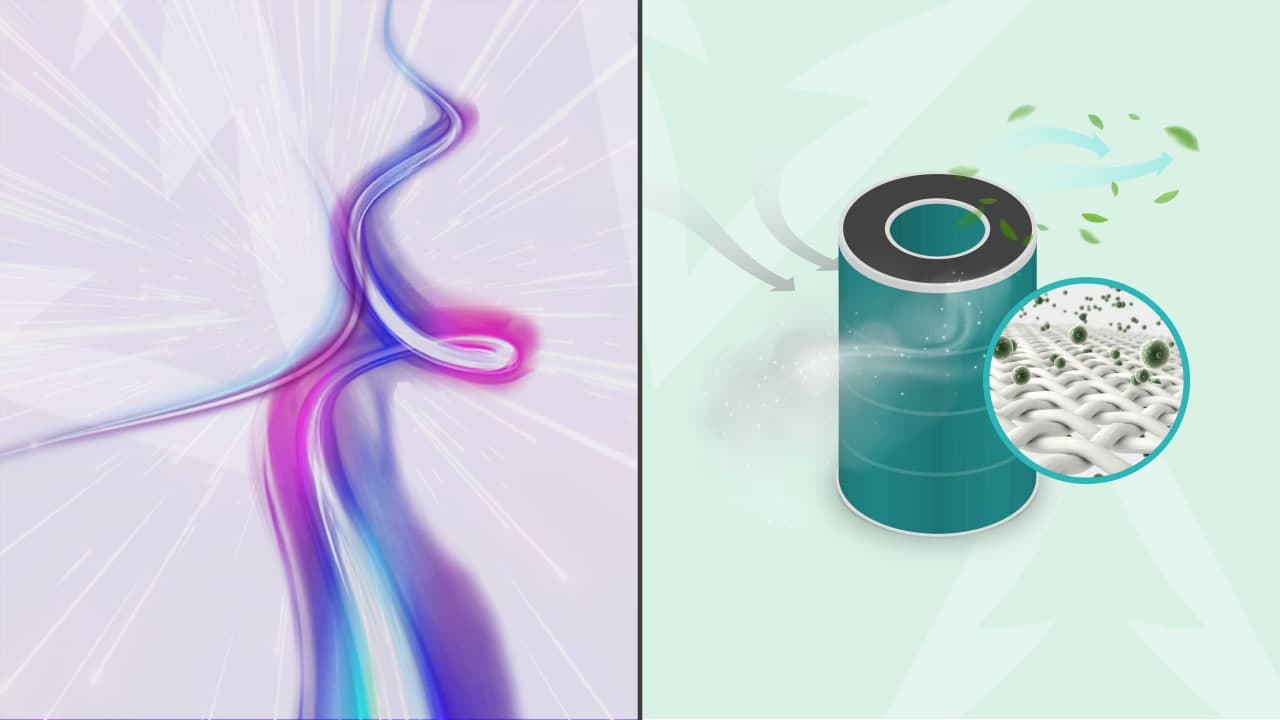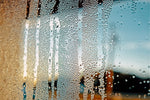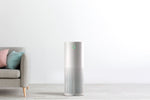Choosing Between UV Air Purifiers and HEPA Filter Purification

Written by Brittany German
UV Light Air Purifiers or HEPA filters?
When it comes to the health of yourself and those around you, knowing how to best purify the air is important. Entering the world of air purification can be confusing with all of the different acronyms, options, and opinions out there.
We're here to try and make your life simple by telling you what the difference is between the two most common air purification methods. There's UV Light air irradiation and HEPA filter air purification.

A simple search online might not give you all the necessary information for you to make an informed decision, so we are outlining it all for you here.
UV Light Air Irradiation
The Acronyms
UV stands for Ultraviolet light (UV). Ultraviolet light is a source of energy and is further broken down into three categories:
- UV-A light: 315–400 nanometers with photons that vibrate just a little faster than visible light.
- UV-B light: 280–315 nanometers, with photons that vibrate even faster.
- UV-C light: 100–280 nanometers, with photons that vibrate the fastest, carrying the most energy, and thus is the most dangerous of the three categories.
What is a photon? A photon is a particle that represents a quantum of light or other electromagnetic radiation.
UVGI stands for ultraviolet germicidal irradiation. UVGI is the use of UV light to kills microbes.
The Process
Air purifiers that use UV Light typically use UV-C. This is the highest energy UV light and is capable of inactivating pathogens and microorganisms by altering the structure and function of microorganism DNA.
UV light treatment for cleaning air rarely works on its own and its actual benefit inside an air purifier is highly questionable. Manufacturers that try to make their products seem more effective by including UV-C lights want you to think that filters catch microbial particles and then the UV light deactivates them. In reality, the residence time of air passing through an air purifier is too short to have an impact on anything airborne and moving that fast.
Units that use UV also have a (hopefully HEPA) filter in place to capture microbial and other particles. However, UV only ends up sterilizing surfaces in the direct line of sight of the bulb. This means only the outermost surface of the filter and any other surfaces in the device receive any of this light. The light doesn't navigate around obstacles and corners and does not penetrate very deeply at all into the dense, random web of hundreds of layers of microfibers that make up filter media.
With each of the four capture mechanisms in play in a HEPA filter, once particles or microbes are captured, they don't get released in normal operation. So, the real workhorse is the HEPA filter which captures particles and keeps them from passing through the filter. They don't even have a chance to be affected by that high energy bulb for which you're being told you need to pay extra.
The Rate of Success
UV light needs to shine on varying particulates anywhere from 6 seconds to 1 minute to effectively destroy it. That might not sound like a long time but when you realize that UV light is taking that time to destroy only 1 square centimeter of air, and you can expel 900 to 300,000 infected particles with just one sneeze, you'll realize how ineffective that really is.
Here’s how long it takes UV light to effectively destroy just one square centimeter of some common viruses and bacteria:

This is why the CDC suggests using HEPA filters as well if you're going to use UVGI equipment. UV Light cleaners cannot replace HEPA filtration.
The Drawbacks
UV Light cannot destroy microorganisms in most residential units without the additional use of a mercury lamp. To deactivate or destroy bacteria, mold, and viruses, an EPA study outlines that a much higher level of UV radiation is required (a level that you wouldn't find in residential units) and prolonged-exposure is required to properly breakdown the particulates (jump to page 26/27).
UV Light cannot eliminate allergens. Most allergens are either particles, spores, or proteins (attached to particles). They're not alive, so they can't be killed. While some proteins may be denatured given enough exposure time, the physical particles on which the problem proteins are hitching a ride are not affected by UV.
UV Light cannot remove VOCs. Not only are VOCs unaffected by UV-C Light, the intense energy of UV light can actually cause VOCs to off-gas faster, or convert them into an even more dangerous substance.
UV Light air cleaners can generate ozone. UV Light can cause oxygen (O2) to break apart. These individual oxygen radicals can combine with other oxygen molecules to form O3, ozone. Exposure to ozone, even short periods of exposure, can lead to respiratory problems, and deadly health conditions.
Inactivated bacteria can reactivate. Biocontaminants after being partially inactivated reach a stage called viable but nonculturable (VBNC). In this dormant stage, biocontaminants may not be able to multiply, but they are still viable and can have an impact on health.
UV Light is damaging to us and the purifier. Exposure to UV Light can burn our skin and damage our eyes. At more serious levels of brief UV exposure, we are susceptible to permanent skin and eye damage, as well as cancer. The UV-C energy used to break down DNA found in contaminants as well as in us, also breaks down the materials that make up an air purifier. Without special coating to lessen the effects (although not stop them) UV-C also attacks air purifiers from the inside out because of its capability to destroy cotton fibers, plastics, gaskets and types of metal. In the long term, the light is damaging the various gaskets and components of the air purifier.
The Takeaway
At its best, UV Light irradiation could deactivate harmful contaminants if air travelled much slower through air purifiers. While some manufacturers say otherwise, UV Light simply does not work fast enough to do what it's made for.
HEPA Filter Air Purification
The Acronym
HEPA stands for high-efficiency particulate air (or arrestance) filter.
The Process
An air purifier with a HEPA filter can capture different sizes of particles. HEPA filters are made by layering microscopic fibers in a dense and randomly packed way that leads to different capture mechanisms for particles of all different sizes. Made correctly, HEPA air purification systems are able to capture virtually all particle sizes even down to the nano level, according to a 2016 NASA study on air purification solutions for space vehicles.
Air that travels through the air purifier with the HEPA filter will force the particles to come in to contact with the filter and become trapped, thus only purified air is released from the device and circulated throughout the room.
HEPA filters can capture more than 99.97% of particles smaller than the COVID-19 coronavirus in just one pass.
The Rate of Success
HEPA is able to capture all particle sizes from large dust and pollen down to viruses and even nanoparticles. HEPA is the total solution for all airborne particulates. A true calling card for HEPA filtration is its ability to capture Covid-19 particulates and its ability to reduce allergic reactions and asthma triggers through the capture of microns.
A micron is a microscopic particle (1/1000 of a millimeter). To put this into perspective, a single strand of human hair is typically between 20-200 microns.
The Drawbacks
While HEPA filters can capture virtually all airborne particle sizes, some pollutants like VOCs are not particles at all and cannot be addressed by HEPA filters alone. In this case, pair the HEPA filter with an activated carbon filter for the capture of these gaseous chemicals.
HEPA filters need to be regularly replaced which comes at a higher cost. The replacement of these filters is very important to the optimal operation of a HEPA-enabled purifier, but some might find that extra price deterring.
There are many terms for HEPA filters floating around. It can be difficult or confusing to find a provider that has a true HEPA filter which is defined by its performance. Other terms like "HEPA-like" and "HEPA-type" might look like a true HEPA filter, but they don't meet that all-important capture efficiency definition that makes it function well enough for nuclear facilities and space exploration.
The Takeaway
True HEPA filters are a reliable product and recommended by the CDC for viral capture. HEPA filters capture 99.97% of particles as small as 0.3 microns in diameter. You also won't have to worry about any negative side effects with the HEPA filter because it doesn't use any harmful chemicals to purify the air.
HEPA Air Purifiers with UV Light
There is the option to use UV Light cleaners inside an air purifier that also uses a HEPA filter. This is something to avoid. Because of the destructive tendencies that UV-C possesses, it can destroy an air purifier from the inside out, including the materials that make up the HEPA filter itself.
The CDC outlines negative possibilities of using a UVGI system, and the EPA cannot recommend the use of UVGI systems as there is not enough research to back up any recommendation. Regardless, even if UVGI was well tested, FDA approved, and actually worked, it would still be working alongside HEPA filters, which works just as well on its own.
The Ultimate Takeaways: UV Light Air Purifiers or HEPA Filters?
HEPA continues to thrive, trapping and purifying 99.97% of contaminants, including Covid-19 particles and those pesky allergens.
While UV Light "cleaners" need HEPA air purification to actually remove allergen, dust, viral, and other microbial particles from the air, HEPA does not need UV to be successful - in fact the addition of UV or UVGI is not significantly additive to the excellent capture capabilities of true HEPA performance filters.
You'll likely feel like the air you're breathing is cleaner, if purified by a HEPA filter.
Back to Blog


